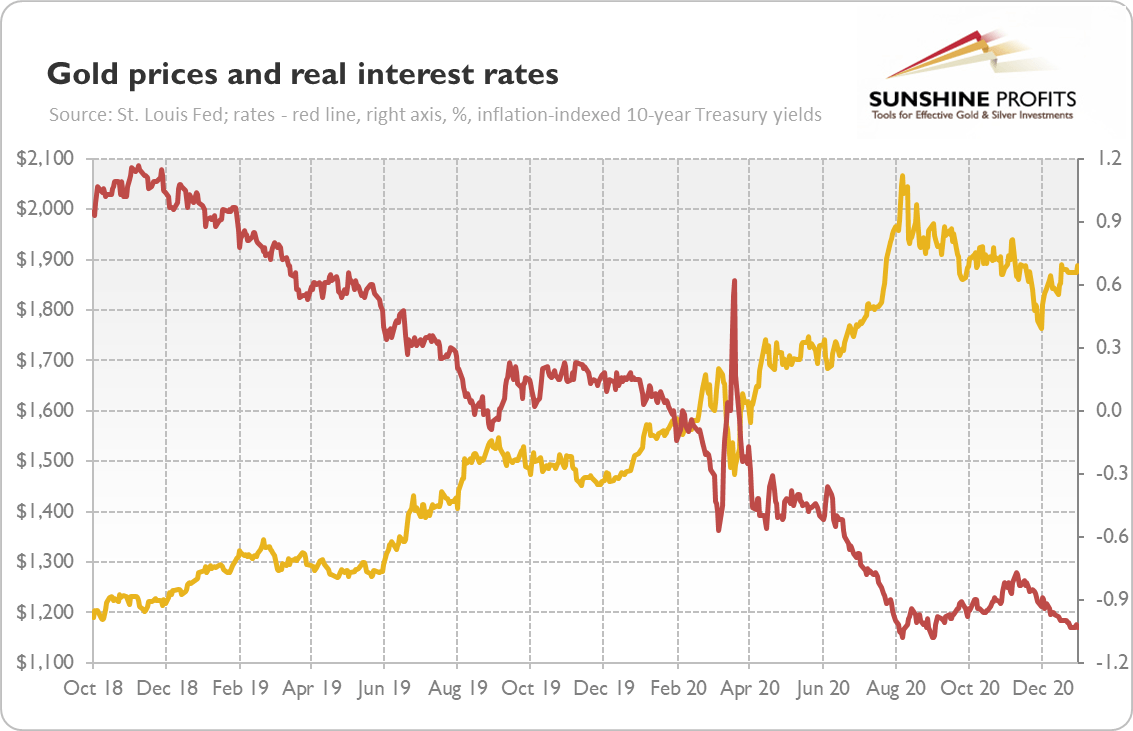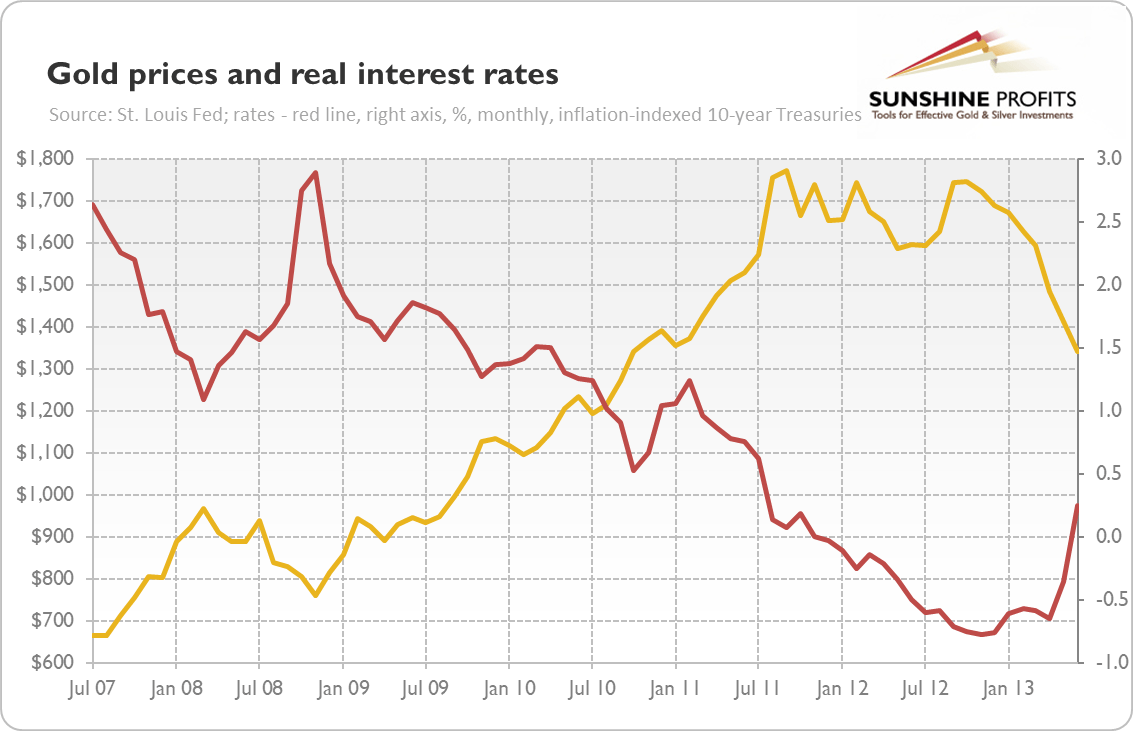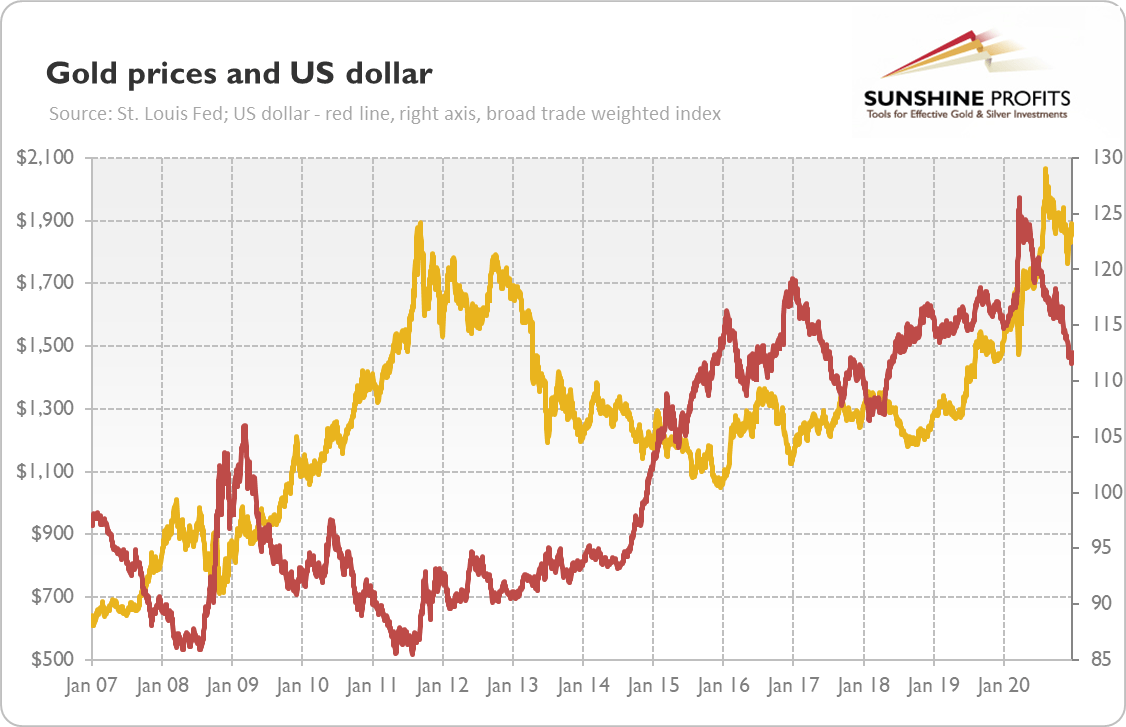The decline in the real interest rates is the most important downside risk for gold. Will it materialize, plunging the price of the yellow metal?
The rise in inflation is the most significant upside risk for gold this year, but there are also a few important downside risks. The most disturbing for us is the possibility that the real interest rates will increase. Why? Please take a look at the chart below.
As you can see, there is a strong negative correlation between the real yields and gold prices . When the interest ratesgo up, the yellow metal falls, and when the rates go down, gold rallies . Indeed, the real interest rates peaked in November 2018 at 1.17 percent, just one month before the last hike in the Fed’s last tightening cycle . Since then, they were falling, reaching their historical bottom below -1.0 percent in the summer of 2020. Not coincidentally, gold was experiencing a bull market during this period, reaching its record high of almost $2010, just when the rates bottomed. And, as the rates normalized somewhat, the price of gold corrected to the level below $1,900.
Now, the obvious question is whether there is further room for real interest rates to go down . In 2019, they were falling amid the economic slowdown and the dovish Fed cutting the interest rates. Last year, they plunged even further (with a short spike because of the surge in the risk premium ), as a result of the COVID-19 related economic crisis and the U.S. central bank slashing the federal funds rate to practically zero.
However, the Great Lockdown and resulting deep downturn are behind us. When we face the second wave of the pandemic and people become vaccinated, there will be an economic recovery. As well, the Fed has already brought the interest rates to zero – meaning that without the U.S. central bank implementing NIRP , the nominal policy rates reached their lower bound. So, assuming that the Fed will not cut interest rates further and that investors will not expect a further slowing down of the economy, the room for further declines in the real interest rate is limited.
The only hope lies in the increase in inflation expectations, which is actually quite probable, as I explained in the previous part of this edition of the Gold Market Overview . Given the surge in the broad money supply , the pent-up demand, and some structural shifts, reflation in 2021 is more likely than it was in the aftermath of the great financial crisis .
However, gold investors should also be prepared for a negative scenario of low inflation. After all, the Fed has repeatedly undershot its annual inflation target. In this case, the real interest rates may stay roughly the same or they could even rise.
Let’s take a look at the chart below, which shows the gold prices and real interest rates after the Great Recession . In the very aftermath of the Lehman Brothers’ bankruptcy , they surged, but after the panic phases ended, they were falling until the end of 2012, just when, more less, the bear market in gold started.
Now, somebody could say that the real interest rates were falling for four years until reaching bottom at the end of 2012, so we shouldn’t worry about the normalization of interest rates. However, the COVID-19 related economic crisis was very deep, but also very short. Everything is happening now at an accelerated speed, so we could already be reaching the local bottom in the interest rates (or be close to it).
Of course, there are important differences between that period and today . First, as I’ve already emphasized, there is now a higher risk of an increase in inflation. Second, in 2013, there was a taper tantrum , while today, the Fed maintains an ultra-dovish stance and does not signal any interest rate hikes in the foreseeable future. Although the U.S. central bank didn’t expand its quantitative easing in December, showing that it feels comfortable with some increases in the bond yields , it’s not going to accept substantial rises in the interest rates. The dovish Fed’s bias is one of the main factors behind the downward trend in the real interest rates (even if they normalize somewhat, they reach further lower peaks and bottoms over time).
Third, the U.S. dollar looks different. As the chart below shows, the greenback started to appreciate in 2011, pushing gold prices down. But today it is more likely that the U.S. dollar will weaken further due to a changing administration in the White House, the economic stabilization and cash outflows into developing countries, soaring public debts, a zero-interest rate policy, and the risk of an increase in inflation.
If so, the normalization of the real interest rates (if it happens, which is far from being certain) doesn’t have to plunge the yellow metal . In other words, there are important downside risks to the bullish case for gold this year, but 2021 does not have to look like 2013 in the gold market.
Want free follow-ups to the above article and details not available to 99%+ investors? Sign up to our free newsletter today!
All essays, research and information found above represent analyses and opinions of Przemyslaw Radomski, CFA and Sunshine Profits' employees and associates only. As such, it may prove wrong and be a subject to change without notice. Opinions and analyses were based on data available to authors of respective essays at the time of writing. Although the information provided above is based on careful research and sources that are believed to be accurate, Przemyslaw Radomski, CFA and his associates do not guarantee the accuracy or thoroughness of the data or information reported. The opinions published above are neither an offer nor a recommendation to purchase or sell any securities. Mr. Radomski is not a Registered Securities Advisor. By reading Przemyslaw Radomski's, CFA reports you fully agree that he will not be held responsible or liable for any decisions you make regarding any information provided in these reports. Investing, trading and speculation in any financial markets may involve high risk of loss. Przemyslaw Radomski, CFA, Sunshine Profits' employees and affiliates as well as members of their families may have a short or long position in any securities, including those mentioned in any of the reports or essays, and may make additional purchases and/or sales of those securities without notice.
Recommended Content
Editors’ Picks

EUR/USD consolidates weekly gains above 1.1150
EUR/USD moves up and down in a narrow channel slightly above 1.1150 on Friday. In the absence of high-tier macroeconomic data releases, comments from central bank officials and the risk mood could drive the pair's action heading into the weekend.

GBP/USD struggles near 1.3300 amid renewed US Dollar demand
GBP/USD is paring back gains to trade near 1.3300 in the European session. The data from the UK showed that Retail Sales rose at a stronger pace than expected in August, briefly supporting Pound Sterling but the US Dollar comeback checks the pair's upside. Fedspeak eyed.

Gold hits new highs on expectations of global cuts to interest rates
Gold (XAU/USD) breaks to a new record high near $2,610 on Friday on heightened expectations that global central banks will follow the Federal Reserve (Fed) in easing policy and slashing interest rates.

Pepe price forecast: Eyes for 30% rally
Pepe’s price broke and closed above the descending trendline on Thursday, eyeing for a rally. On-chain data hints at a bullish move as PEPE’s dormant wallets are active, and the long-to-short ratio is above one.

Bank of Japan set to keep rates on hold after July’s hike shocked markets
The Bank of Japan is expected to keep its short-term interest rate target between 0.15% and 0.25% on Friday, following the conclusion of its two-day monetary policy review. The decision is set to be announced during the early Asian session.

Moneta Markets review 2024: All you need to know
VERIFIED In this review, the FXStreet team provides an independent and thorough analysis based on direct testing and real experiences with Moneta Markets – an excellent broker for novice to intermediate forex traders who want to broaden their knowledge base.


